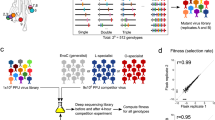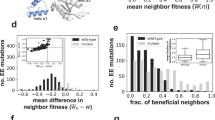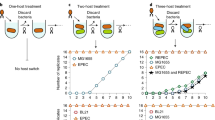Abstract
The primary impediment to formulating a general theory for adaptive evolution has been the unknown distribution of fitness effects for new beneficial mutations1. By applying extreme value theory2, Gillespie circumvented this issue in his mutational landscape model for the adaptation of DNA sequences3,4,5, and Orr recently extended Gillespie's model1,6, generating testable predictions regarding the course of adaptive evolution. Here we provide the first empirical examination of this model, using a single-stranded DNA bacteriophage related to φX174, and find that our data are consistent with Orr's predictions, provided that the model is adjusted to incorporate mutation bias. Orr's work suggests that there may be generalities in adaptive molecular evolution that transcend the biological details of a system, but we show that for the model to be useful as a predictive or inferential tool, some adjustments for the biology of the system will be necessary.
This is a preview of subscription content, access via your institution
Access options
Subscribe to this journal
Receive 12 print issues and online access
$209.00 per year
only $17.42 per issue
Buy this article
- Purchase on Springer Link
- Instant access to full article PDF
Prices may be subject to local taxes which are calculated during checkout


Similar content being viewed by others
References
Orr, H.A. The distribution of fitness effects among beneficial mutations. Genetics 163, 1519–1526 (2003).
Gumbel, E.J. Statistics of Extremes (Columbia University Press, New York, 1958).
Gillespie, J.H. A simple stochastic gene substitution model. Theor. Popul. Biol. 23, 202–215 (1983).
Gillespie, J.H. Molecular evolution over the mutational landscape. Evolution 38, 1116–1129 (1984).
Gillespie, J.H. The Causes of Molecular Evolution (Oxford University Press, New York, 1991).
Orr, H.A. The population genetics of adaptation: the adaptation of DNA sequences. Evolution 56, 1317–1330 (2002).
Fisher, R.A. The Genetical Theory of Natural Selection (Oxford University Press, Oxford, UK, 1930).
Orr, H.A. The population genetics of adaptation: the distribution of factors fixed during adaptive evolution. Evolution 52, 935–949 (1998).
Orr, H.A. Adaptation and the cost of complexity. Evolution 54, 13–20 (2000).
Hartl, D.L. & Taubes, C.H. Towards a theory of evolutionary adaptation. Genetica 102/103, 525–533 (1998).
Haldane, J.B.S. A mathematical theory of natural and artificial selection. V. selection and mutation. Proc. Camb. Philos. Soc. 28, 838–844 (1927).
Orr, H.A. A minimum on the mean number of steps taken in adaptive walks. J. Theor. Biol. 220, 241–247 (2003).
Rokyta, D., Badgett, M.R., Molineux, I.J. & Bull, J.J. Experimental genomic evolution: extensive compensation for loss of DNA ligase activity in a virus. Mol. Biol. Evol. 19, 230–238 (2002).
Wahl, L.M., Gerrish, P.J. & Saika-Voivod, I. Evaluating the impact of population bottlenecks in experimental evolution. Genetics 162, 961–971 (2002).
Wahl, L.M. & Gerrish, P.J. The probability that beneficial mutations are lost in populations with periodic bottlenecks. Evolution 55, 2606–2610 (2001).
Swofford, D.L. Phylogenetic Analysis using Parsimony* (PAUP*) ver. 4.0. (Sinauer Associates, Sunderland, Massachusetts, 1998).
Thompson, J.D., Higgins, D.G. & Gibson, T.J. CLUSTAL W: improving the sensitivity of progressive multiple sequence alignment through sequence weighting, position-specific gap penalties and weight matrix choice. Nucleic Acids Res. 22, 4673–4680 (1994).
Minin, V., Abdo, Z., Joyce, P. & Sullivan, J. Performance-based selection of likelihood models for phylogeny estimation. Syst. Biol. 52, 1–10 (2003).
Acknowledgements
We thank J.J. Bull, Z. Abdo, H.A. Orr and L. Wahl for discussions and comments. This work was supported by a grant from the US National Institutes of Health.
Author information
Authors and Affiliations
Corresponding author
Ethics declarations
Competing interests
The authors declare no competing financial interests.
Supplementary information
Rights and permissions
About this article
Cite this article
Rokyta, D., Joyce, P., Caudle, S. et al. An empirical test of the mutational landscape model of adaptation using a single-stranded DNA virus. Nat Genet 37, 441–444 (2005). https://doi.org/10.1038/ng1535
Received:
Accepted:
Published:
Issue Date:
DOI: https://doi.org/10.1038/ng1535
This article is cited by
-
Distribution of fitness effects of mutations obtained from a simple genetic regulatory network model
Scientific Reports (2019)
-
The Impact of Population Bottlenecks on Microbial Adaptation
Journal of Statistical Physics (2018)
-
Causes of molecular convergence and parallelism in protein evolution
Nature Reviews Genetics (2016)
-
Quantitative evolutionary dynamics using high-resolution lineage tracking
Nature (2015)
-
Constructive neutral evolution: exploring evolutionary theory’s curious disconnect
Biology Direct (2012)



